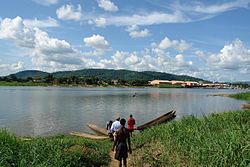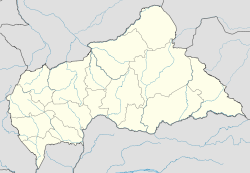
Bangui
About this schools Wikipedia selection
SOS Children, which runs nearly 200 sos schools in the developing world, organised this selection. SOS Children has looked after children in Africa for forty years. Can you help their work in Africa?
| Bangui | |
|---|---|
| Ubangi (Oubangui) River at the outskirts of Bangui | |
|
|
|
| Coordinates: 4°22′N 18°35′E Coordinates: 4°22′N 18°35′E | |
| Country | |
| Prefecture | Ombella-M'Poko |
| Government | |
| • Mayor | Jean-Barkes Gombe-Kette |
| Area | |
| • Total | 67 km2 (26 sq mi) |
| Elevation | 369 m (1,211 ft) |
| Population (2006) | |
| • Total | 622,771 |
| • Density | 9,295.1/km2 (24,074/sq mi) |
Bangui is the capital of and the largest city in the Central African Republic. The majority of the population of the Central African Republic lives in the western parts of the country, near Bangui. Though located within Ombella-M'Poko prefecture, it is an independent commune, and thus politically independent of the surrounding prefecture.
History
The city was founded in 1889 in what was then the French colony Haut-Oubangui ('Upper Ubangi'), later renamed Oubangui-Chari and made part of French Equatorial Africa. Named for local rapids, the city grew around the French military post on the Ubangi river. Bangui served as an administration center in the colonial era and continues to be the administrative centre of the CAR.
Widespread violence in Bangui followed the March 1981 elections, which took place following a French operation to depose Jean-Bedel Bokassa in 1979 and replace him with David Dacko. Opponents of unpopular Dacko laid siege to Bangui and compelled his flight to exile. Andre Kolingba then formed the Comité Militaire pour le Redressement National (See History of the Central African Republic).
In October 1985, a conference of public health officials including representatives of the Centers for Disease Control and World Health Organisation met in Bangui and defined AIDS in Africa as, "prolonged fevers for a month or more, weight loss of over 10% and prolonged diarrhoea". About half the AIDS cases in Africa based on the Bangui definition are HIV positive.
A French Jaguar aircraft crashed in Bangui in March 1986, killing 35 and leading to a resurgence in anti-French sentiment. Andre Kolingba, however, continued to allow the French to maintain military bases in the Central African Republic.
Some 200 Central African Republic soldiers mutinied in Bangui in May 1996, demanding back pay and the resignation of President Ange-Félix Patassé. French troops stationed in the country quelled the mutiny. The renegades, however, heavily looted Bangui and killed more than 50 people.
After President Patassé announced a national unity government in early 1997, mutinous troops refused to relinquish a military base in Bangui. New fighting erupted in June.
Rebel leader Francois Bozize took power by seizing Bangui in March 2003, ousting Patasse. The situation in the town is now improving, but regular instability is being noticed.
Late 2006, Sudanese rebel forces, supposedly following up the Chadian armed ones, entered the North-eastern part of the country. The French army is still present in CAR, officially to protect and assist to the local army. Better armed and organized, French military planes (Mirage type) had to respond by bombing the places were rebels were stationing. The situation is said to be mastered.
Mercer Human Resources Consulting named Bangui as the 214th worst city out of 215 in their 2009 quality of living survey. Baghdad was the only city to be ranked lower than Bangui.
Geography and climate
Geography
Bangui lies on the northern banks of the Ubangi River just below a series of rapids that limit major commercial shipping farther upriver, on the southern border. The navigable Ubangi River turns sharply south below Bangui and connects to the Congo River just south of the equator near Brazzaville as its chief northern tributary. The river marks the border between the Central African Republic and the Democratic Republic of the Congo (DRC). The Congolese town of Zongo sits opposite the river from Bangui.
The city centre lies near the river and features a large triumphal arch dedicated to Bokassa, the Presidential Palace and the central market. Lying 5 km further north, the heart of the residential area has the largest market and most nightlife. North of the city lie rolling hills.
Climate
The Central African Republic is situated just north of the Equator and consequently throughout the year daily high temperatures rarely fall below the high 80s Fahrenheit. Bangui features a tropical wet and dry climate. The rainy season lasts from May until October. Bangui, being in the south of the country and thus closest to the equator, is slightly hotter and wetter than the northern parts of the country.
Several of the neighborhoods of Bangui are in low-lying areas and are prone to recurrent urban flooding. For instance, severe rains in June and July 2009 left 11,000 people homeless.
| Climate data for Bangui | |||||||||||||
|---|---|---|---|---|---|---|---|---|---|---|---|---|---|
| Month | Jan | Feb | Mar | Apr | May | Jun | Jul | Aug | Sep | Oct | Nov | Dec | Year |
| Source: BBC Weather | |||||||||||||
Law and government
Bangui is an autonomous commune (commune autonome) of the Central African Republic. With an area of 67 km², it is by far the smallest high-level administrative division of the CAR in area but the highest in population as of 2003. The city of Bangui consists of 8 urban districts (‘arrondissements’), 16 groups (‘groupements’) and 205 neighborhoods (‘quartiers’).
Economy
Bangui serves as an administrative, trade, and commercial centre. It received its first bank branch in 1946 when the Bank of West Africa (BAO) established a branch there. Bangui manufactures include textiles, food products, beer, shoes, and soap. The main exports are cotton, timber, coffee, and sisal. Because of the ongoing strife, unemployment hovered near 23% in the city as of 2001.
Transport
Bangui hosts a river port and is served by Bangui M'Poko International Airport ( IATA airport code BGF); the former handles the overwhelming majority of the country's international trade. River ferries sail to Brazzaville and Zongo. Roads connect the city to Cameroon, Chad, and Sudan.
Telecommunications
Two GSM-900 mobile telecommunications companies, Telecel CAR and Nationlink Telecom RCA, operate out of Bangui. State-owned Socatel is the principal telecom in CAR and Bangui, and is responsible for the operation and maintenance of the communications infrastructure.
Restaurants
There are three types of restaurants in Bangui.
First, those with French orientation, although they may have African ambiance and/or some African food. These include "Relais des Chasses", "L'Equateur", "Tropicana", and "L'Escale".
Second, there are restaurants focusing on foreign cuisine, such as the Lebanese "Ali Baba" and "Beyrouth", and a Chinese restaurant simply known as "Chinese Restaurant".
Third, there are numerous African restaurants very popular especially among locals, which include the celebrated "Madame M'boka".
A number of bars and street food stalls also complement Bangui's culinary scene.
Culture
Several periodicals and three daily newspapers publish in Bangui. Other attractions in Bangui include Boganda Museum and Bokassa Palace. The Cathédrale Notre-Dame in Bangui is the seat of the Roman Catholic Archdiocese of Bangui.
Archaeology
Archaeological studies in and around the city have yielded at least 26 ancient Iron Age sites that contain many metallurgical tools and objects, illuminating the pre-European history of the city and surrounding area.
These archaeological sites were added to the UNESCO World Heritage Tentative List on 11 April 2006 in the Cultural category.
Education
Bangui is home to the University of Bangui, founded in 1970. A public institution, the University of Bangui monopolizes non-agricultural college education in the Central African Republic.



